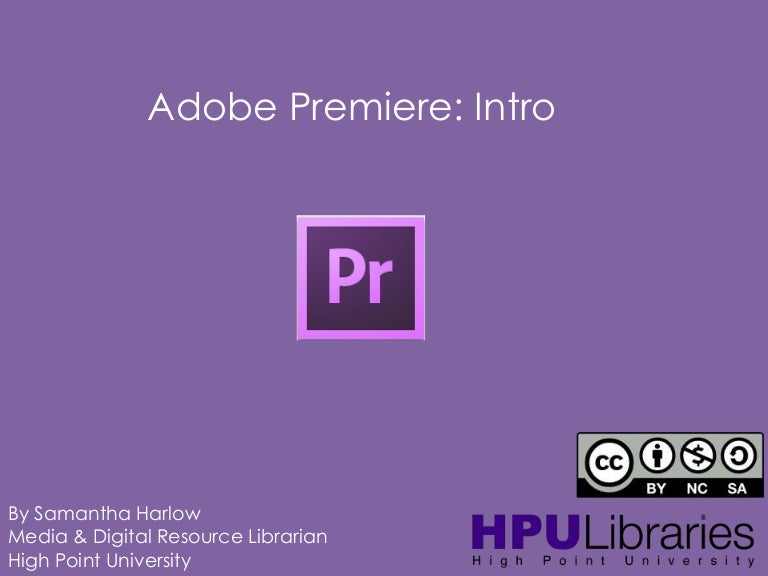Tutorial Adobe Premiere Cs3 Pemula
Adobe Premiere Pro CS3 merupakan program untuk mengedit dan mendesain suatu film atau video. Pada umumnya Adobe Premiere Pro CS3 memang sering digunakan untuk mengedit suatu movie, tetapi Anda dapat pula menggunakan perangkat lunak ini untuk membuat suatu desain iklan digital untuk memenuhi kebutuhan dunia periklanan audio visual. Premiere Pro CS3 Essential Training on Adobe Press Premiere Pro CS3 Essential Training on cynda.com. Premiere Pro CS3 Essential Training on Adobe Press Premiere Pro CS3 Essential Training on cynda.com. Tutorial:Premiere Pro CS3 Essential Training. Classic editor History Talk (0) Share. Adobe Photoshop CS3 7 PALETTES Below is the description of the most commonly used palettes in Adobe Photoshop CS3. Palettes used for more advanced image editing will be covered in the Adobe Photoshop CS3 Tutorial - Intermediate. NAVIGATOR The Navigator palette (Fig. 1) allows you to resize and move around within the image.
. ProsIncludes Encore CS3 and OnLocation CS3. New time-remapping tool.


Now available in a Mac version. ConsNo AVCHD support. This version drops one good image-stabilization tool. Minimal DVD authoring from the timeline. Bottom LineOn the Windows platform, a very capable and usable editor is somewhat improved, though largely through separate, formerly third-party programs.
Mac users get a new alternative to Final Cut Proone that has excellent suite integration but a noticeably leaner feature set than its Windows counterpart. (8/29/07) editor's note: originally this review incorrectly stated that adobe ultra cs3 is included in the premiere pro cs3 package. Ultra cs3 is, however, included with the production premium cs3 suite. This change does not affect the product's rating or our conclusion.for many, the anchor tenant in adobe creative suite 3 is the video editor, premiere pro ($799 direct). From an interface and suite integration standpoint, premiere pro is largely unchanged since my review of.
Adobe Cs3 Tutorial
Premiere pro does come with several new programs, including adobe encore cs3, which we plan to review separately, since the company may unbundle the dvd-authoring package. The most significant change is the introduction of a macintosh version. Windows users will find modest changes, both good and bad. Premiere pro cs3 comes without 2d3's excellent steadymove video stabilization utility. Those who have the plug-in from adobe production premium 2.0 can install it in the windows version of cs3.
The production premium cs3 suite includes after effect's stabilize motion function, which produces good results but often requires much more hands-on effort. Those who don't have the steadymove plug-in but buy premiere pro (for mac or windows) as a standalone product will lack a motion stabilizer. Another loss in this version of premiere pro: you can't produce dvds with menus from the timeline (a graphical representation that shows significant video frames in chronological orderhandy for simple projects). Reportedly, this change prompted the bundling of encore; thus you gain sophisticated capabilities but lose the simple workflow. On a positive note, premiere's time remapping gives you the simplest technique i've seen for gradually changing speeds in a video file. It works by using keyframes that you insert either in the timeline or in the effects controls window.
I like working in the timeline, where you start by enabling keyframes and choosing time remapping: speed as the effect to be adjusted by the timeline's rubber-band controls. With time remapping, when you insert a keyframe, premiere pro actually inserts two: one each for the starting and ending speeds.for example, suppose you wanted to slow a video from 100 percent to 25 percent over the course of 1 second. You'd drag the second keyframe inserted by premiere pro 1 second to the right, then drag the rubber band control down to 25 percent speed. You can even customize the rate of speed change with blue handles that appear when you click either keyframe.the time-remapping technique uses advanced frame blending to produce the motion effect, as opposed to the timewarp feature in after effects, which uses pixel motion, a method that supposedly delivers superior quality. Timewarp is extraordinarily challenging to implement, however, so most producers will prefer to use time remapping.adobe onlocation (formerly serious magic dv rack), provides on-set monitoring and direct-to-disk recording. I find the first functionwhich lets you quickly calibrate your camera, check levels, and keep an eye on your signalmuch more important, because unless you work on the same set day after day, optimizing lighting and exposure in your shoots is always a challenge.onlocation includes a waveform monitor, which by itself is worth the price of admission.
Adobe Premiere Pro Cs6 Download
The feature graphically represents the brightnessaka luminanceof the pixels in the video frame using the ire (institute of radio engineers) scale, which defines true black and white as 7.5 ire and 100 ire, respectively. Exceed these levels and your video won't fall within broadcast standards (won't be 'broadcast legal'). More important, your video will lose detail at one or both ends. The monitor's two configurable 'zebra stripes' (patterns of alternating black and white lines superimposed on the image to indicate areas with different degrees of exposure) help ensure that faces in the videousually the most important content in the frameare well exposed. You can monitor overexposure with the first and facial exposure with the second, a capability no camera can match. Onlocation also supplies automated quality meters that alert you if brightness exceeds the 'broadcast legal' level and if audio levels are high enough to cause distortion.